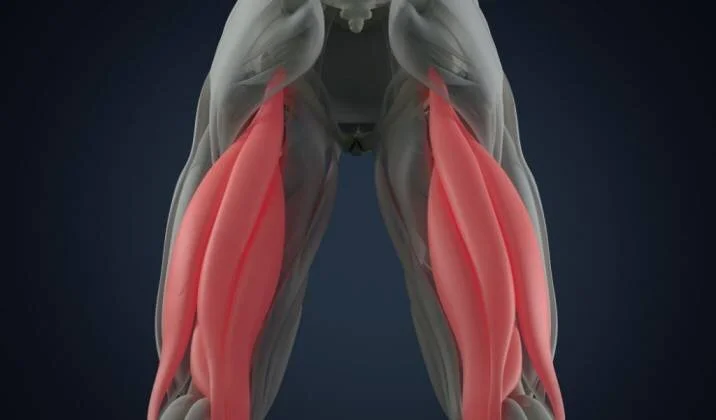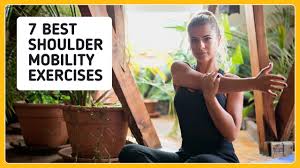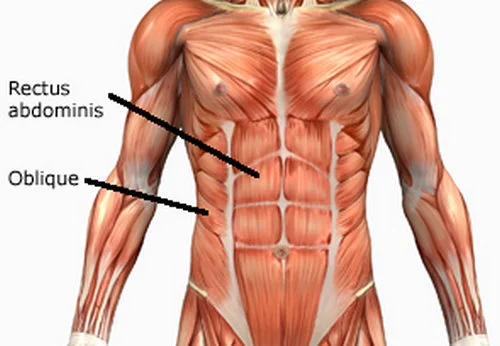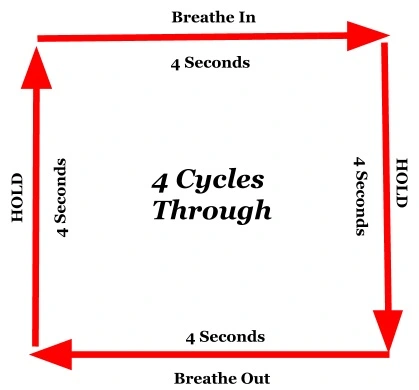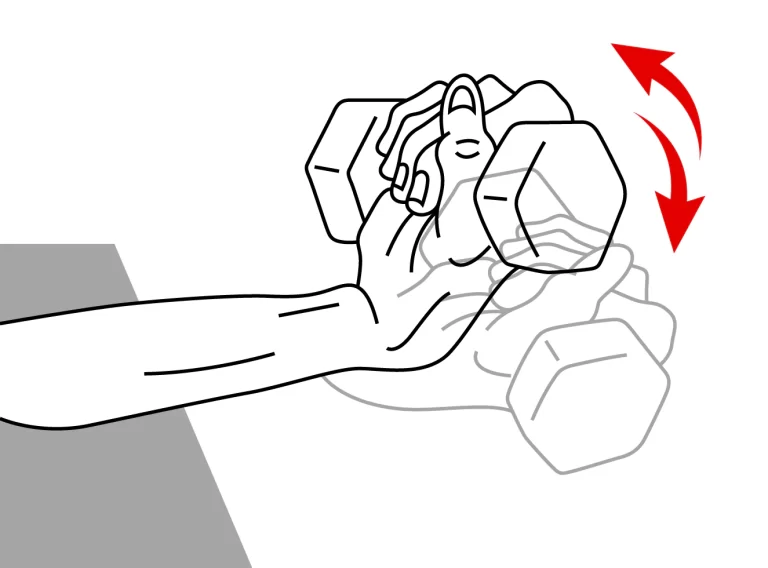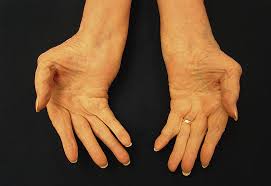Top 14 Hamstring Exercises for Strength, Power, and Injury Prevention
Whether you’re an athlete looking to enhance your sprinting capabilities, a fitness enthusiast aiming for a well-rounded physique, or someone simply seeking to improve day-to-day mobility, incorporating targeted hamstring exercises into your workout routine is essential.
Join us as we delve into the anatomy of the hamstrings, the benefits of training these muscles, and a curated selection of effective exercises designed to unlock the full potential of your lower body. Get ready to embark on a journey toward stronger, more flexible hamstrings and discover the transformative impact they can have on your overall fitness and well-being.
Table of Contents
What is a Hamstring Exercise?
The posterior compartment of the thigh contains a trio of long muscles called the hamstrings, which work together to shape the surface anatomy of this area. The semitendinosus, semimembranosus, and biceps femoris muscles are all part of the hamstring group of muscles.
Because they all attach to the proximal portions of the tibia and fibula, the hamstring muscles are closely related to one another. They are innervated by the tibial and common fibular (peroneal) divisions of the sciatic nerve (L4 to S3).
Every muscle in the hamstrings crosses and acts onto the knee and hip joints. The hamstrings’ main job is to flex the knee and extend the hip, which allows for the execution of several crucial lower-body exercises like sprinting, climbing, and walking. Additionally, the hamstrings play a crucial stabilizing role; in a standing position, they remain passive when the body weight is evenly distributed between the two lower limbs.
To stabilize the hip joint and stop falling, these muscles, contract and oppose the tilting movement when a person begins to tilt forward. Additionally, the hamstrings and collateral ligaments work together to support the knee joint because of where their insertions are located.
Hamstring muscle exercise includes different exercise
- Exercise Techniques To Increased Flexibility And Range Of Motion
- Exercise Techniques To Increased Strength of the Muscles
Hamstring Exercises- Techniques To Increased Flexibility And Range Of Motion
When attempting to increase Range Of Motion, the mechanics of the tibiofemoral and patellofemoral joints and their importance in lower extremity function must be respected. Because the knee joint is a weight-bearing joint, the need for stability takes precedence over the need for mobility, although mobility coupled with adequate strength is also necessary for normal function.
Neuromuscular Inhibition Techniques
Patient position and procedure
Supine, with the hip and knee as extended as feasible, is the patient’s position. Using your hand proximal to the ankle, create an isometric hold to resist knee flexion movement. Next, have the patient relax before having them passively (or actively) extend their knee joint to the end of its range (using hold-relax and hold-relax/agonist-contraction procedures, respectively).
Patient position and procedure
Prone, with the hip and knee as extended as feasible, is the patient’s position. When the femur is close to the patella, place a tiny cushion or folded towel underneath it to shield it from compressive forces. Use the hold-relax method to enhance knee extension after stabilizing the pelvis to prevent hip flexion.
Benefits of stretching exercise
- Increase muscle blood flow.
- Improve your performance in physical activities.
- Assist your joints in achieving their maximum range of motion.
- Decrease your risk of injuries.
- Enable your muscles to work most effectively.
- Improve your ability to do daily activities.
Passive Stretching Techniques
Always use a low-intensity, long-duration stretch to ensure that the patient stays as relaxed as possible.
Patient position and procedure
The Patient’s position is Prone, hips extended with the patient’s foot off the edge of the treatment table. Place a rolled towel under the patient’s femur just proximal to the patella and weight cuff around the ankle. As the muscle relaxes, the weight places a sustained passive stretch on the hamstring muscle, which increases knee extension.
Patient position and procedure
The patient’s position is Supine, with the knee extended as far as possible. Place a rolled towel or padding under the distal leg to elevate the calf and knee off the table. Secure a cuff weight across the distal femur for sustained stretching.
NOTE: This exercise is not effective for severe knee flexion contractures. Use it only for restrictions that are near the end of the range of knee extension movement.
Self-Stretching Technique
Patient position and procedure:
The patient’s position is Long sitting, with the distal leg, supported on a rolled towel. Have the patient press down with the hands against the femur just above (not on) the patella to cause a sustained force to increase knee extension movement.
Stretching in the Standing position
- Standing and extending both legs simultaneously
- Stretching involves simultaneously stretching both legs while standing.
- As you stand, place your right foot in front of your left.
- Bending at the waist, slowly lower your head to your right knee.
- Maintain a straight kneeling stance.
- Maintain this posture for roughly 15 to 30 seconds.
- then unwind.
- Cross your left foot in front of your right foot and repeat on the other side.
Muscle Stretching with the towel
- Stretching your muscles with a towel is an easy exercise to perform.
- Place your back on the floor.
- Grasp the ends of a long bath towel with both hands while encircling your foot.
- Pull the towel slowly to raise your leg straight up. Make sure your knee remains straight. The other leg ought to stay planted on the ground.
- Raise your leg until the area behind your thigh feels stretched. Your calf region feels stretched out.
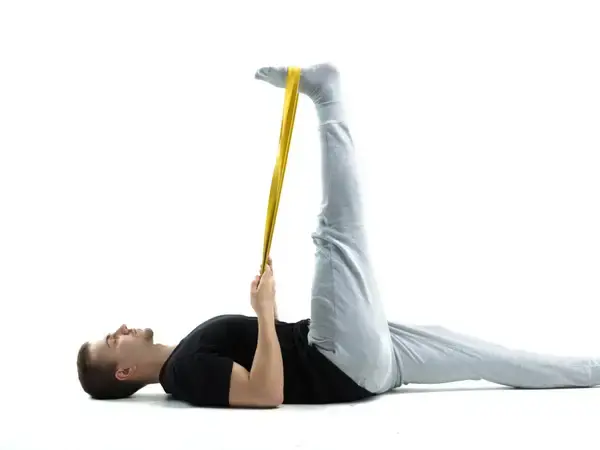
Wall stretching
- At a wall’s corner, one performs a wall stretch.
- Place one leg against a wall and the other on the ground.
- Raising the leg to the maximum possible straightness, gently press the knee on the wall.
- Start with holding the pose for 10 seconds, then progressively increase it to 30.
- For a full set, perform wall stretches four to five times with each leg, one at a time.
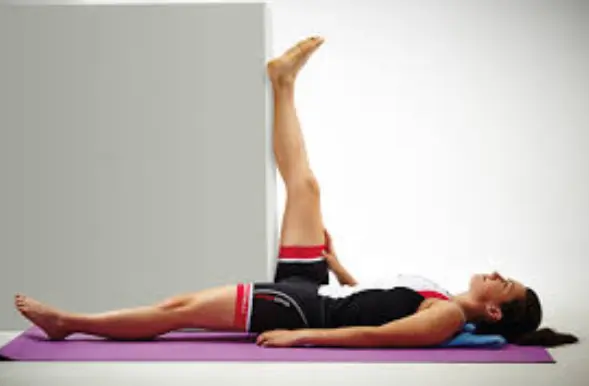
Muscle Stretches While Sitting
- Stretching on your back is a more mild form of stretching than stretching while seated. The degree of a stretch in a sitting position should be determined by the level of pain. A key component of this exercise is to fold forward at the hips rather than rounding your lower back.
- With your heel on the floor, extend one leg in front of your body while sitting on the edge of a chair.
- Sitting tall and shifting your pelvis forward will help you to straighten your spine.
- Hold this stretch for approx 30 seconds.
- Repeat this exercise 3 times for each leg.
- Try to do two times workouts a day.
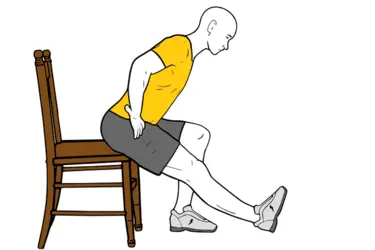
Hamstring Exercises – Strengthen Knee Flexion (Hamstrings)
Benefits of Hamstring strengthening exercise
- Joint flexibility: Strength training maintains joint flexibility and may lessen arthritis symptoms.
- Enhanced muscle mass: As we age, our natural decline in muscle mass occurs, but strength training can help buck the trend.
- Stronger bones: Strength training lowers the risk of fractures and boosts bone density.
- Weight control: Gaining muscle causes your body to burn calories more readily, which makes weight control simpler.
- Balance: Exercises that build strength help improve balance and flexibility, which lowers the risk of falls and accidents.
Hamstring-Setting (Hamstring Sets)
Patient position and procedure
The patient’s position is Supine or long-sitting, with the knee in extension or slight flexion with a towel roll under the knee. Have the patient isometrically contract the knee flexors(Hamstrings) just enough to feel tension developing in the muscle group by gently pushing the heel into the treatment table and holding the contraction. Have the patient relax and then repeat the isometric contraction.
Multiple-Angle Isometric Exercises
Patient position and procedure
The patient’s position is Supine or long-sitting.
With the knee flexed to multiple places within the range of motion, provide mechanical or manual resistance to a static contraction of the hamstring muscles.
To stress the medial or lateral hamstring muscles, respectively, place the tibia in internal rotation or external rotation before resisting knee flexion.
Place the opposing foot behind the ankle of the leg that needs to be resisted to teach the patient how to apply self-resistance at various places in the range of motion.
Hamstring Curls (Open-Chain Knee Flexion)
Patient position and procedure:
The patient’s position is Standing, holding onto a solid object for balance. Have the patient pick up the foot and flex the knee joint.
Maximum resistance from gravity occurs when the knee is at 90 flexions. You can add resistance with ankle weights or a weighted boot. If the patient flexes the hip, stabilize it by having the patient place the anterior thigh against a solid object or wall.

Patient position and procedure:
The patient’s position is Prone. Place a small towel roll or foam rubber under the femur just proximal to the patella to avoid compression of the patella between the treatment table and the femur. With a weight cuff around the ankle, have the patient flex the knee to only 90. Maximum resistance from gravity occurs when the knee joint first starts to flex at 0. If hamstring curls are performed in the prone position using manual resistance, a weight-pulley system or isokinetic equipment resistance to the knee flexors can be applied throughout the range of knee flexion.
PRECAUTION:
Open-chain hamstring curls exercise performed against resistance placed on the distal tibia cause posterior tibial translation. A patient with a Posterior Cruciate Ligament injury or reconstruction should avoid this exercise during the starting stages of rehabilitation.
Closed-Chain Isometric Exercises
Closed-chain isometric exercises are done to facilitate co-contraction of the quadriceps and hamstring muscles.
Setting Exercises
Patient position and procedure:
The patient’s position is Sitting on a chair, with the knee extended or slightly flexed and the heel on the floor. Have the patient press the heel against the ground and the thigh against the seat of the chair and concentrate on contracting the quadriceps and hamstring muscles simultaneously to facilitate co-contraction around the knee joint. Hold the muscle contraction, then relax, and repeat. Use biofeedback to enhance the learning of the co-contraction of the muscles.
Stabilization Exercises
Patient position and procedure:
The patient’s position is Standing, with weight equally distributed through both lower extremities. Apply manual resistance to the pelvis in alternate directions as the patient holds the position. This facilitates isometric contractions of muscles in the hips, knees, and ankles.
you can Increase the speed of application of the resistive forces to train the muscles to respond to sudden shifts in forces. Progress the stabilization activity by applying the alternating resistance against the shoulders to develop stabilization of the trunk and then by having the patient bear weight only on the involved lower extremity while resistance is applied.
Hamstring muscle exercise at Home
Following list of exercises, we can do at home
- Stretch in the Standing position (Both Legs at Once)
- Muscle Stretching with the towel
- Wall stretching
- Muscle Stretches While Sitting
- Hamstring Sets
- Prone hamstring curl
What are the common mistakes to Avoid during Hamstring stretch?
During the stretch, there is one particular error you should avoid making:
- Knee bending: Try to keep your legs extended when sitting for the ideal hamstring stretch. To avoid bending your knees due to tight hamstrings, simply reduce the amount of forward stretch you perform. Keep in mind that it takes time to increase hamstring flexibility.
- Hunching over: Instead of hunching over from the shoulders, try to hinge at the hip level. Imagine attempting to maintain a regular posture for your spine while reaching “up and over the legs.” Maintaining a neutral spine and avoiding bending forward to touch your toes are beneficial postures.
- Not flexing your working leg’s toes: To maintain your leg’s straightness, your extended leg’s toes must point upward.
- Not having a square hip position: Maintain a forward-facing posture and place your hips side by side. By doing this, you can keep your pelvis properly adjusted and prevent uneven hip strain.
- bending your lower back: Keep your pelvis neutral and your lower back as parallel to the floor as you can. This ensures that you stretch your hamstrings safely and avoid straining your lower back. For additional support, you can even place a blanket or towel below your lower back.
- Incorrect alignment: Instead of pushing your posterior out from behind you, be sure your hips are parallel to and directly above your feet. This confirms that your hamstrings are being stretched.
- Overstretching: Although there are more difficult hamstring stretches available, take care not to overuse the band to the point of damage. Take care not to overstretch a strap.
- Moving too quickly: In order to feel the stretch in your hamstrings during a dynamic hamstring stretch, the motion should still be reasonably slow and controlled. Your muscle doesn’t gain anything from the rapid activity.
- Not using your core: Even though this is a hamstring stretch, you should still engage your core to prevent tension in your lower back.
What are the safety and precautions for Hamstring stretch?
Here are a few tips to make this Hamstring stretch safer and more effective:
- Don’t bounce. Bouncing triggers a mechanism called the stretch reflex. This can cause more muscle contraction, not less.
- Lift the sitting bones toward the roof. This lengthens the hamstring muscles.
- Assure your hips are directly over your feet. Your buttocks aren’t behind your feet. This error makes the stretch less effective.
- During the squat stretch, you may need to use a table or another surface to assist you in standing back up if your core muscles are weak.
- Going as far as you can without experiencing back pain or any insecurity is a good rule of thumb for safety.
- Avoid attempting to force a stretch or stretching when in discomfort. Breathe normally while performing stretching exercises. Try to do hamstring stretches in your routine for at least 2-to to 3 days every week.

